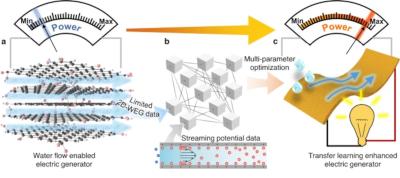Researchers from China's Tsinghua University have constructed highly aligned graphene oxide (GO) nanochannels for sustainable energy production using a freeze-casting process. The new method could address an issue that impedes the generation of electricity from natural water flow through engineered nanochannels, which could become a viable way to cater to the fast-growing renewable power needs.
Large-scale nanochannel integration and the multi-parameter coupling restrictive influence on electric generation currently remain big challenges for macroscale applications, but this novel design encourages spontaneous absorption and directed transfer of water within the nanochannels to generate clean electricity.
The researchers explained that layer-by-layer assembly of 2D graphene oxide layers rich in oxygenated functional groups results in desired and directed structures. Meanwhile, when interacting with water, the variable alteration of functional groups on GO sheets may influence the surface charge density. As a consequence, numerous and designable 2D nanochannels between graphene oxide layers may be consistently incorporated into macroscopic structures, making them suitable platforms for the creation of high-performance water flow-enabled electric generators (WEGs).
In their study, the researchers created a water flow-enabled electricity generator with 2D incorporated graphene oxide nanochannels (2D-WEG) using a rotating freeze-casting process. This 2D-WEG with customizable internal chemical and structural properties can capture water naturally and stimulate water flow within nanochannels to create considerable electrical power.
In addition, given little experimental data, the researchers used a transfer learning (TL) technique to handle the challenging multiparameter coupling adjustment for the 2D-WEG. The team said that in contrast to previously published single-parameter studies, the TL technique utilized in this work can give homogeneous multiparameter simulation and extremely accurate efficiency prediction even with a limited experimental dataset.
Consequently, the as-prepared 2D-WEG has remarkable mechanical adaptability and can create a high voltage of 2.9 V or a current of 16.8 A, as well as controllably change the output efficiency to meet practical needs. A simple parallel or series connection of 2D-WEGs may boost power production to 11.9 V and 82.7 A, respectively.
Additionally, the researchers created a variety of water-enabled electricity-generating devices, such as the waterscape display, the architectural panorama, and the 2D-WEG fan. These WEG systems can power scientific calculators, LED panels, and computerized ink displays, highlighting the material's potential for future clean energy development.
Based on these results, it seems that the as-fabricated 2D-WEG and TL optimization techniques may have considerable promise for constructing a viable water-enabled energy system.


